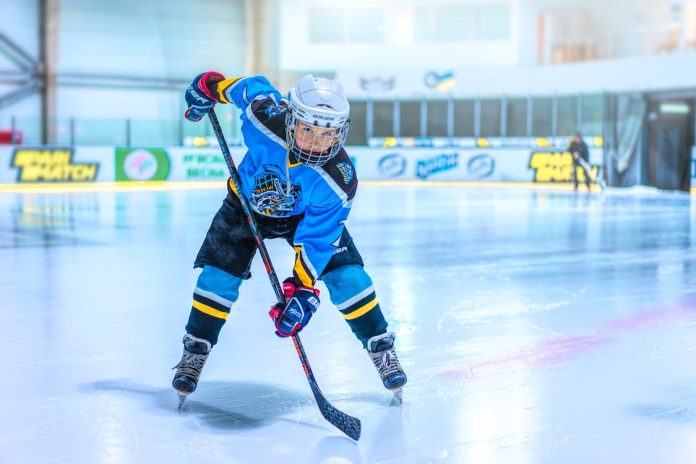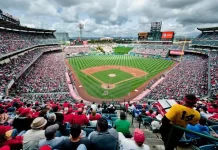A popular outdoor sport around the world, hockey attracts millions of spectators and enthusiastic players. There are a lot of variations in hockey, but ice hockey has gained worldwide popularity, particularly in the US, Canada, and Europe. Millions of people watch the famous NHL events all year round.
If you love ice hockey, this comprehensive guide is for you! Scroll down as we give a detailed insight into the game, its rules, and how to play ice hockey like a pro!
Table of Contents
Ice Hockey Equipment
Before you start playing ice hockey, it’s important to know the basic equipment you need to play the game. Besides basic sports equipment, players require safety sports gear to avoid getting injured. The following hockey equipment is the most important for beginners:
Hockey Stick: A hockey stick is made of wood or wove carbon fiber and fiberglass blend. Hockey sticks are available in single pieces as well as replicable shafts and blades. Players get to choose the material according to their personalized needs. A goal stick, for example, has a larger blade than players in the defense position. There are numerous lengths and styles of hockey sticks; it is up to the player to choose the right size and length for their hockey stick. You can find the precise length of a hockey stick according to the player’s age and height. Wondering what size hockey stick you need? Check out HockeyMonkey’s stick sizing guide.
Hockey Puck: A hockey puck is a rubber disk with a 3-inch diameter and 1-inch thickness. A hockey puck is basic sports equipment, and the team pushing the hockey puck into the goal wins a point.
Skates: Skates are essential sports gear. Before buying skates, ensure they fit you properly and include a toe cup made of hard plastic or steel. Skates that are too big or small cause pain and interrupt your balance during play, and they must also provide ample ankle support. Ensure your skates are sharp to prevent them from getting trapped in ice furrows.
Helmet: A helmet is the most important ice hockey safety equipment to protect players from injuries. Before buying a helmet, ensure it is certified by HECC (Hockey Equipment Certification Council) and fits properly on the head, chin, and face. Using a helmet without a complete facemask and a protective chin cup and strap during a game can be hazardous. Secure your helmet and fasten the chin strap to keep it in place before heading to the playing field.
Safety Gear: Apart from the basic equipment like skates, helmets, sticks, and pucks, you need safety gear to avoid injuries and play safely. Following is a list of safety equipment you need to start playing ice hockey:
- Shoulder pads
- Elbow pads
- Knee and shin pads
- Hockey pants or breezes (to provide padding to the front, rear, and sides of the upper legs and groin.
- Gloves
- Neck protector
- Mouthguard
- Athletic supporter and cup
- Leg pads, arm pads, chest protectors, and catcher and blocker gloves for goalies.
Number of Players and Game Duration
Ice hockey is a fairly easier game compared to other types of hockey. The rules are not complex; you can start playing once you know your basics. Ice hockey typically has two teams of 6 players each. These players are specialized in their field and play at positions like forwards, goalkeepers, and left and right defense. A complete team usually has 17 to 22 players, with six on the field at all times, and the remaining are ready for a replacement at any time.
Each ice hockey game is 60 minutes long and divided into three periods. Match referees may allow overtime or a shootout in case of a tie.
Rink Dimensions
The ice hockey rink is rectangular with a 60m length and 25-30m width. It has three major sections marked with blue lines on the ice field. A thick red line indicated the center of the rink, and players of each team must remain on their side before faceoff. A thin red line borders the rink, and if the puck crosses the red border line, the opposite team takes the puck and resumes from the exact point.
You will notice circles in red and blue on the rink. The blue circle crossing the center red line indicates an area for a faceoff, while the red circles on each half are faceoff areas used after a penalty. A blue semicircle on each side of the rink indicates the goalie’s area.
Basic Rules of Play
For every beginner, it’s important to understand the basic rules to start playing and practice their skills. Here are some basic rules and penalties:
Faceoff
Faceoff is a term that refers to the start of the game. Once the referee drops the puck, the players take their positions and stand opposite each other near the red line. A game begins with a faceoff and ends with either a goal or an official blowing the whistle.
Scoring a Goal
A team scores a goal and earns a point when a player slides the puck into the goal net without a penalty. The team scoring the most goals wins at the end of the three periods. If there is a tie, the referee gives 5-minute overtime to allow teams to score a goal. The team scoring a goal in overtime wins the game. In overtime, each team can have a maximum of three skaters on the ice.
Offside
Offside happens when a player crosses the red line before the puck. An attacker can only enter the offensive zone following the puck. A two-line pass is another type of offside, in which a player receives the pass by crossing a blue line and a center red line – offside results in a faceoff.
Icing
Icing occurs when a player from one team shoots the hockey puck from their side of the center, and it lands beyond the opposing team’s goal line or when it is touched by another team player other than the opposing team’s goalkeeper. Icing also results in a faceoff.
Penalties
For each penalty, the player involved in the penalty gets a two-minute minor. Every player other than the goalies has to knock the puck immediately after they receive it; otherwise, they land into a penalty. Other than that, players face a penalty if:
- They deliberately pull down a player from behind.
- Behave unethically on the rink.
- Use the stick dangerously or hold the stick too high.
- Players indulge in hooking or tripping.
If a player gets involved in a major penalty, the referee sends them out for 2-5 minutes. During this penalty time, you cannot substitute a player and must play with the remaining team.
Practice Your Skating, Braking, and Shooting Skills
Before playing a game, try practicing your skating and braking skills to gain more control over your movements. Start practicing by skating backward and forwards and slow down or stop by pushing the ice down or turning your skaters on a side. Once you master these skills, practice your puck shooting and moving skills.
Final Thoughts
Ice hockey is a great sport for those who love to skate and play a fast game. By going through this comprehensive guide, you can equip yourself with all the right skills and knowledge, practice your basic skills, and become a pro with consistent practice.








